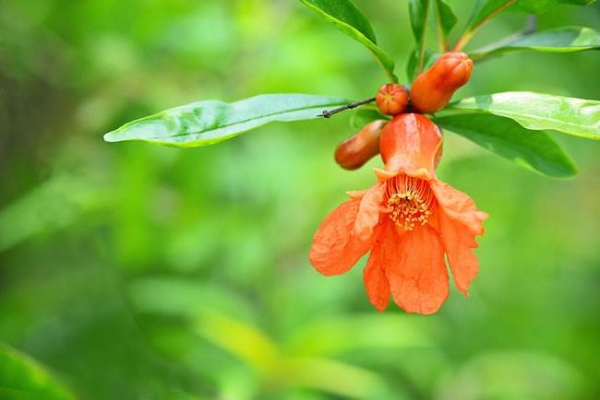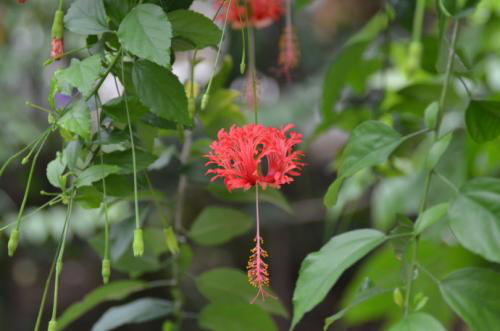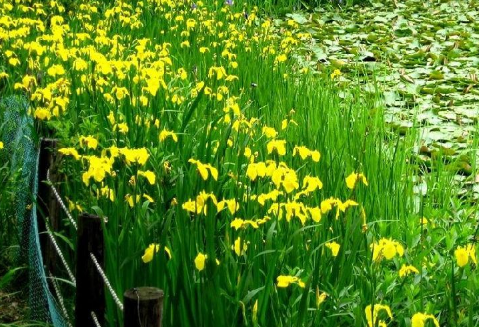Matters needing attention in pomegranate flower culture
Pomegranate flower planting water management is very important. According to the principle of "timely watering during drought and timely drainage during waterlogging", we can spray some water on the leaves every morning and evening to increase the water content of the leaves. In the process of watering and fertilizing pomegranate flowers, it is necessary to see wet and dry, so either dry and then water, do not be half-dry and half-wet, or too wet, which is not conducive to pomegranate flower culture. And pomegranate flowers like a sunny and dry environment, so pot culture should be placed in a place with plenty of light.

How to raise pomegranate flowers, matters needing attention when potted pomegranate flowers bloom
I'm sure you've all heard of pomegranate flowers. This is a deciduous shrub or small Arbor pomegranate flowers, it has a high use value and medicinal value, so many people have breeding, but because some people do not know how to raise pomegranate flowers, so in the breeding process did not pay attention to the cultivation of pomegranate flowers, so breeding is not very smooth, so I would like to carefully understand the cultivation methods and matters needing attention of this pomegranate flower. So let's take a look at how to raise pomegranate flowers and the matters needing attention when potted pomegranate flowers bloom.
Brief introduction of pomegranate flower
First of all, let's take a look at pomegranate flowers. Pomegranate flower, also known as an pomegranate, golden pomegranate, Jinpang, Tulin, Tianju, Zhu Shi, Ruo pomegranate, Dan Ruo and Shanli leaves, is the flower of deciduous shrubs or small Arbor pomegranate, and is also a flower of the genus Pomegranate of the pomegranate family. In fact, this kind of flower is mainly originated in Iran and Afghanistan in Central Asia, but with the development of the times, it is not only the national flower of Libya in North Africa, but also one of the city flowers of Zhao Zhuangsi in Shandong Province, Shiyan City, Huangshi City and Jingmen City in Hubei Province. Xinxiang City, Henan Province, Xi'an City, Shaanxi Province and Hefei City, Anhui Province, it can be seen that it has a high status in people's hearts.
Different from ordinary flowers, pomegranate flower is a kind of hermaphroditic flower, which can be divided into complete flower and incomplete flower according to the degree of development of flower pistil, in which complete flower is a gourd-shaped or barrel-shaped flower, which is called big-ass fruit flower, while incomplete flower is a flower whose calyx tube is trumpet-shaped and cannot be fertilized, so it is called bell-shaped flower or pointed butt flower. Pomegranate flower has good use value and medicinal value. Its use value is mainly that it can observe both flowers and fruits, and it is often used as pot decoration, but the medicinal value has a long history. Pomegranate flower can be used as medicine a long time ago, and it has good effects of clearing away heat and detoxification, moistening the lungs and astringent intestines, invigorating the stomach and stopping bleeding and so on.
How to grow pomegranate flowers
In general, the main methods of cultivating pomegranate flowers are cutting, ramet and striping propagation. Among them, the cutting propagation is mainly in spring, and the biennial semi-lignified pomegranate branch cuttings can be selected. Branch cuttings can take root in about half a month. The ramet propagation is mainly in April in spring, when pomegranate flowers are just the period of bud germination, so it is OK to dig up strong roots and tillers and plant them separately. As for striping propagation can be in spring or autumn, similar to ramets, bud germination period by digging strong roots and tillers pressed into the soil.
Matters needing attention in flowering and culture of potted pomegranate
Of course, now more people still prefer to cultivate pomegranate flowers by potted plants. Pomegranate flower pot culture is relatively simple, but there are still many points for attention, including: pomegranate flowers like a sunny and dry environment, so pot culture should be placed in a place with plenty of light. Aquaculture should strictly control the amount of water, dry should not be wet, usually watering can not be too much. In addition, to control the growth of pomegranate flowers, it is necessary to pick hearts for them in time during the growth period to promote the formation of their flower buds.
Conclusion: the above is the introduction about how to raise pomegranate flowers and the matters needing attention in potted pomegranate flower culture. I believe you have some understanding about this. All in all, pomegranate flower is a kind of plant that is easy to raise, but it still needs to be taken care of carefully.
Culture methods and matters needing attention of pomegranate flower
Everyone has tasted pomegranate flowers. Gongju soaked in water can clear the fire and relieve fever. Pomegranate flowers and wild chrysanthemums as well as Hangzhou white chrysanthemum are very familiar to everyone. In addition to clear eyes, heat, detoxification, but also has the role of ornamental layout of the garden, beautify the environment. Let's take a look at the pomegranate flower culture methods and matters needing attention.
Culture methods and matters needing attention of pomegranate flower
1. pomegranate flower culture method-- water
Pomegranate flower planting water management is very necessary, according to the principle of "timely watering during drought and timely drainage during waterlogging", pomegranate flowers can be watered every morning and evening to increase the water content of the leaves. In the process of watering and fertilizing pomegranate flowers, it is necessary to see wet and dry, so either dry and then water, do not be half-dry and half-wet, or too wet, which is not conducive to pomegranate flower culture.
2. pomegranate flower culture method-- temperature
Pomegranate flowers in winter planting management should pay attention to keep warm, the southern region of pomegranate flowers in the flower fade, the stems and leaves will gradually wither, after watering can wait for overwintering. At this time, soil mulching should be carried out on the leaves, which can promote soil ventilation and improve the ability of pomegranate flowers to survive the winter.
III. Pomegranate Flower Culture method-- fertilization
Pomegranate flowers can be improved by fertilization, but do not apply fertilizer early, or too much fertilizer can also cause root damage.
- Prev

Matters needing attention in raising mulberry potted plants with family chandelier
1. Root-knot nematode disease is a widely distributed and serious disease, especially in the process of chandelier mulberry culture, when reddish-brown spots appear on the edge of leaves. When expanding inward, be careful. At this time, the soil can be changed and aldicarb granules can be applied to the new soil.
- Next

Sowing method of Acorus calamus
1. The fruit of Gladiolus is basically ripe in mid-January, and the seeds can be taken out of the picked fruit. The seeds can be sown after picking. If you want to store the seeds, dry them first, refrigerate them at a low temperature in the refrigerator, and sow the seeds in March or September next year. two。 Sow seeds and flatten loose soil in changing pots.
Related
- Fuxing push coffee new agricultural production and marketing class: lack of small-scale processing plants
- Jujube rice field leisure farm deep ploughing Yilan for five years to create a space for organic food and play
- Nongyu Farm-A trial of organic papaya for brave women with advanced technology
- Four points for attention in the prevention and control of diseases and insect pests of edible fungi
- How to add nutrient solution to Edible Fungi
- Is there any good way to control edible fungus mites?
- Open Inoculation Technology of Edible Fungi
- Is there any clever way to use fertilizer for edible fungus in winter?
- What agents are used to kill the pathogens of edible fungi in the mushroom shed?
- Rapid drying of Edible Fungi

